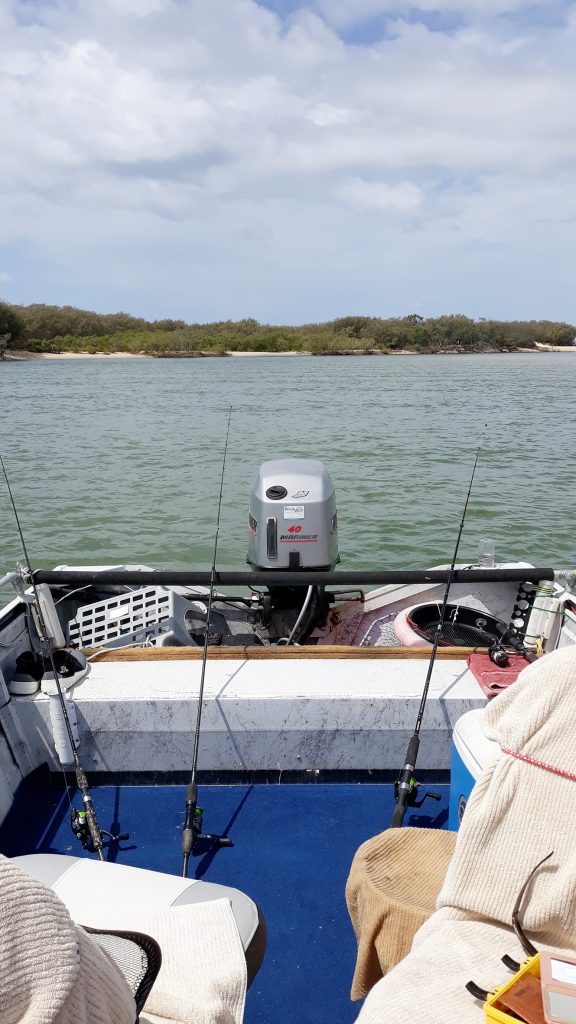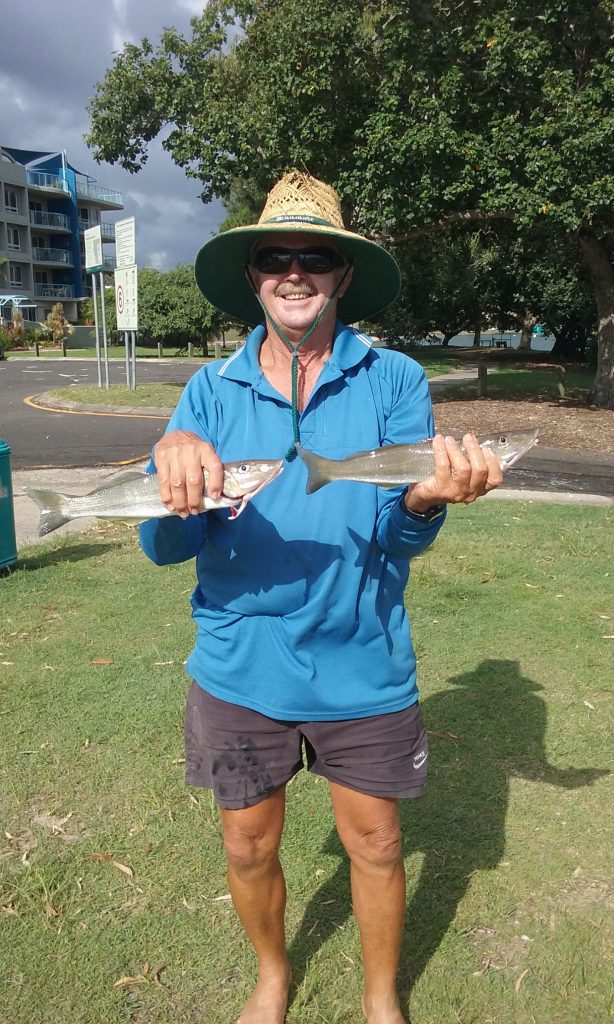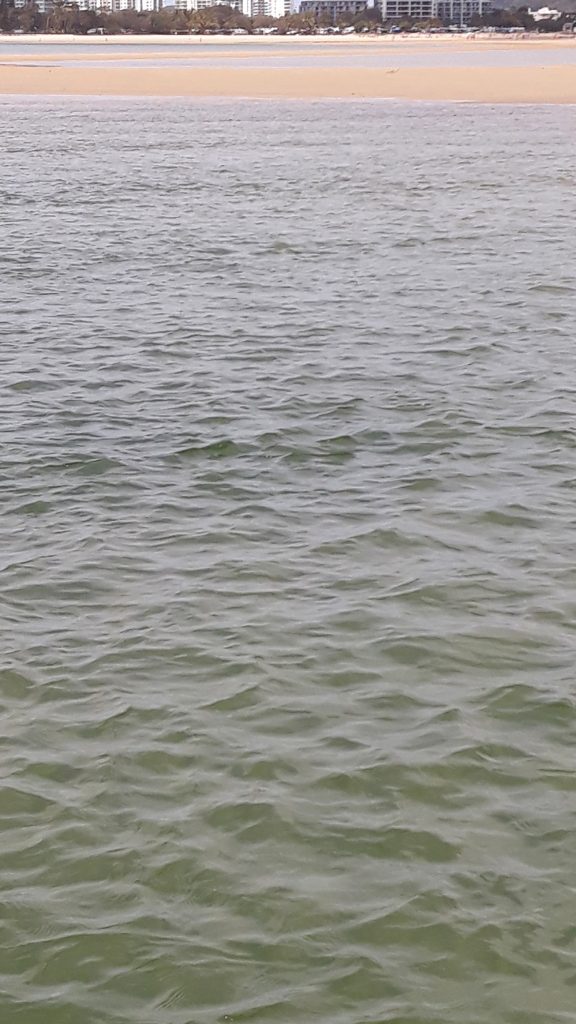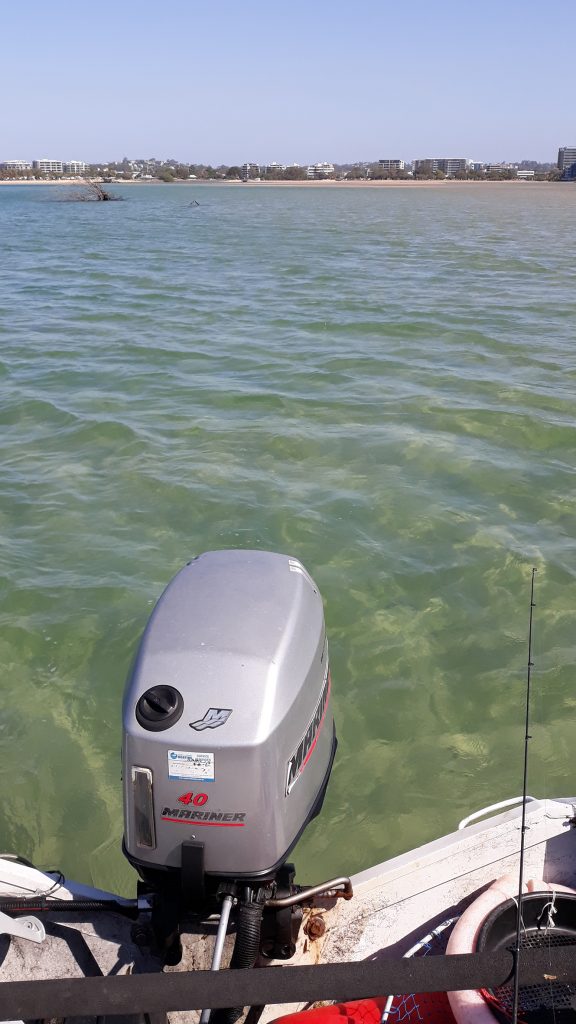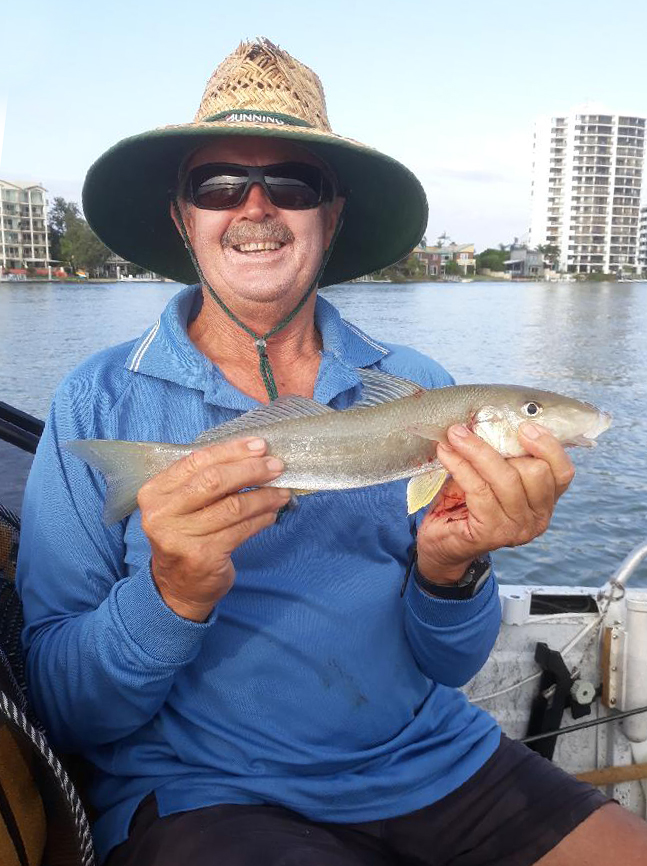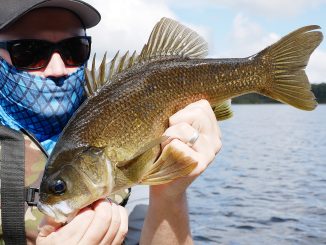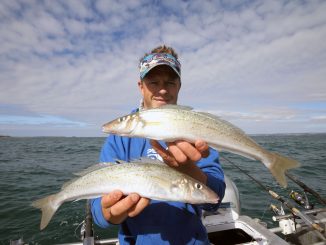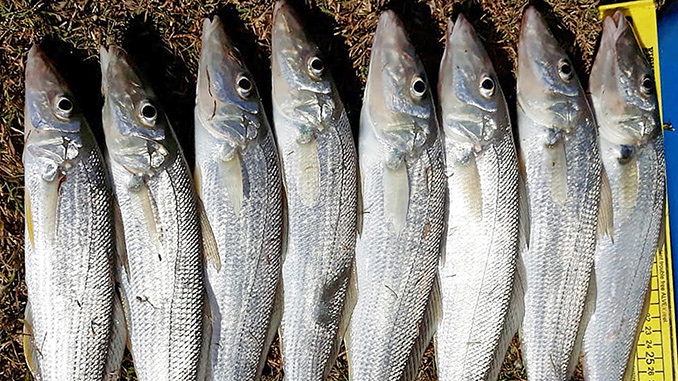
by Mal McKinlay •
The Maroochy River is centrally located on the Sunshine Coast, one of Australia’s premier holiday destinations. It meanders from its northern headwaters in the Blackall ranges south through hinterlands, agriculture and urban subdivisions where it swings in a west to east direction meeting the ocean at Maroochydore. Most East Australian estuary fish species are well established in these waters.
I have been fishing the Maroochy for 12 years and during this period I have seen a huge improvement in the ecology systems of the river. This does not mean there has been a great increase in the numbers of fish living there, rather there has been a vast recovery in the bait resources of the river. I put this down to the demise of the sugar cane farms (pesticide and fertilizer run off) that used to line the banks of the Maroochy but have now been replaced by urban developments. The yabby banks have increased three-fold in this period and the soldier crab population is abundant and flourishing. These are a popular and favourite food of all estuary species and most offshore juvenile species as well.
I divide my fishing time on the river into two seasons – summer and winter – with a crossover period for both. Last winter (2019) was one of the best seasons I have experienced for yellowfin bream in both size and quantity.
The most exciting time to fish the Maroochy is in summer when the sand whiting, also called yellowfin or summer whiting, return to the river after their winter sojourn in the ocean. You will always catch the odd whiting even in the middle of winter, but the ‘elbow-slappers’ can be targeted from the September full moon right through to March/April full moon the following year.
Okay, so what is classed as an elbow-slapping whiting? I regularly catch fish between 35-40cm in the Maroochy River. When you hold a fish of this magnitude in the palm of your hand, its tail will most certainly be slapping close to your elbow. Of course, smaller fish down to legal size (23cm) are always in the mix but with the right tackle, bait and the correct approach, your chances of catching bigger fish are increased dramatically.
PREPARATION
When planning an outing I always check the weather, tide and moon forecasts. I recommend the Willy Weather, Maroochy River-Picnic Point, as their predictions have proven most accurate.
I plan my trip so I gather yabbies or soldier crabs from the sand banks on the falling tides, fish to the bottom of the tide, then fish the first two hours of the run-in. Alternatively, I will gather my bait the day before and keep it alive overnight to fish the run-in tide right up to the top.
TACKLE
For most of my whiting fishing, I have used long, one-piece whippy 12ft fibreglass rod with an Alvey side cast reel and 6lb mono. There is nothing better than watching that rod tip dip as a whiting takes the bait. However, since moving to the Sunshine Coast I have switched my tackle to short boat rods, as they are simpler to store on board and make the task of landing a large whiting much easier. There are lots of 7-8ft rods on the market that are fantastic for handling big whiting – check in with your local tackle store for recommendations.
I also switched from a side cast to a thread line reel, and from 6lb mono/nylon to a 6lb braid with 4-6lb fluorocarbon leaders. My strike rate remains the same, if not better, because of the direct feel to the fish that braid line can give. Once you switch to braid, you’ll be hooked for life!
However, I did talk one of the old guys, who has been fishing the river longer than I have, into trying braid. I think he lasted one trip before he went back to nylon! I have seen him land some monster whiting using his old, one-piece fibreglass rods and trusty Alvey reels. So, if it ain’t broke, why fix it?
There are many good brands of braid on the market today that will meet your requirements. I prefer the new 8 strand-weave braids that are strong with a round, smooth profile. They are quite soft compared to some of the original 4 strand braids. To my 6lb braid main line, I splice in about 3m of 6lb fluorocarbon leader, then slide a No.3 running sinker on to the leader and attach it to a rolling swivel. Connecting about 1m of 4lb fluorocarbon trace to the swivel, I place 2-3cm of red tubing on it to act as a fish attractant, then finish off with a Mustad Size 4 Ex-Long Shank Bloodworm hook (see Fig.1).
In faster flowing water, I increase the sinker size to suit so I can maintain the bait in the whiting’s feeding zone.
BAIT
To catch big whiting you must use live bait, and the number one bait for sand whiting in just about every estuary and river in Australia is bloodworms. Beach worms will work in the rivers close to the mouth but cannot be compared to the impact bloodworms have on whiting. Unfortunately, bloodworms are very hard to come by on the Sunshine Coast. Some tackle shops do sell them here, but they will cost you an arm and a leg.
Nevertheless, Mother Nature has given us a bountiful supply of alternative bait on the Maroochy – yabbies and soldier crabs.
Yabbies (or nippers, as they are called south of the border) can be pumped at just about any sand or mud bank that is exposed at low tide on the river. The best way to find them is to go over the banks when the tide is in and search for the holes where they live.
In the lower reaches you will find them around Chambers Island and along the Picnic Point esplanade foreshore. Channel and Goat islands are joined in the middle of the river by mangrove tidal flats and the sand flats of these islands are home to the healthiest yabby banks in Queensland.
The downside of using yabbies is that they tend to attract lots of little pickers and pest fish. Therefore, my favourite bait for elbow-slappers on the Maroochy is the humble little soldier crab.
Soldier crabs are prolific in the river on just about any mud or sand bank. From half run back tide they pop out of the ground and team over the banks, churning up the sand’s surface as they feed on the millions of microbes and bacteria that live here. On a nice sunny day they stay out until the bottom of the tide then disappear as if someone waved a magic wand.
Elbow-slapper whiting are absolute suckers for small soldier crabs. Why would you pay $20 for a handful of worms when you have an unlimited supply of the next best thing running around at your feet for free?
WHEN TO FISH
I always try to plan my fishing trips around the full moon or the new moon. At these times, the tides are biggest at high water and smallest at low water. This means that a greater volume of water is moving in and out of the river during the tidal period. Over the years, I have found that the faster the water is running, the more active whiting are on the bite.
I have fished the neap tides that occur in between the full and new moon and the pace of the water is very lazy, and so are the whiting. My simple fishing rule is ‘slow water, slow bite…fast water, hold on tight!’
So I get asked a lot whether incoming or out-going tide is best? When I first started fishing the Maroochy I only ever fished the incoming tide for whiting. I soon realised that there are just as many opportunities, if not more, on the outgoing.
When the tide is making, the whiting come out of the deeper channels and work their way across the sand flats as the water starts to cover them, searching for yabbies and soldier crabs. Working exactly in reverse on the outgoing tide, they come off the banks, and fall back into the deeper gutters and channels waiting to ambush a tasty morsel being swept along in the current.
The Maroochy River becomes extremely clear when it doesn’t rain for a month or so. All species in the river, including big whiting, become very shy in crystal clear water. One of the reasons I like the run-out tide is that from half tide down, the receding current stirs the sand up giving these big cautious fish a little bit of cover.
Another problem on the river during peak whiting season in December-January is the amount of traffic on the river from holidaymakers. This is when night fishing comes into its own, as the river is quiet. I know several fishos who only fish for whiting at night and regularly catch fish to 40cm.
A great time to plan a whiting trip to the Maroochy is immediately after a severe rain event when 300ml or more has fallen in a short period. The fresh run-off from connecting creeks and storm water outlets flushes all the big whiting down to the lower reaches where they congregate in great numbers looking for clean saltwater and food. You can always pick which fish are from upstream because they are a very dark colour. Some of my most successful trips have been when the river is a deep chocolate brown colour and the water is fresh enough to use on the garden.
WHERE TO FISH
I divide the Maroochy river into 2 parts, upstream from the motorway bridge and downstream from the bridge to the bar mouth at Cotton Tree.
There are good whiting banks upstream in the Bli Bli reaches of the river and big whiting are caught here. I have never fished for them anywhere except in the downstream section where there are unlimited places to fish.
Look for whiting in the same places you look for their bait. As you travel downstream from the motorway bridge, the river is at its widest. If you look over to the left-hand side you will see the mangroves of the north shore. There are plenty of sand banks and undulations along this side of the river suitable for whiting.
On the right-hand side is Chambers Island, which is surrounded by channels and sand banks. On the same side of the river you have the esplanade foreshore of Picnic Point, a kilometre stretch that lends itself well to land-based fishos.
Proceeding further down, is the joined islands of Channel and Goat islands. These islands act as a large natural buffer from the ocean waves that come through the mouth of the river at Cotton Tree. This whole region of river is the home to many different species of fish, and is where I catch all my elbow slapper whiting.
TECHNIQUE
I fish with two rods at once resting on a padded cross bar across the back of my boat. When I am searching for a patch of fish I will start off with three rods, but it doesn’t take long for a decent size whiting to tie the three lines together on the retrieve. So after 20 minutes of sorting out a tangled mess of braid and fluoro leaders, I go back to two rods.
I load my hook up with small soldier crabs, preferably no bigger than your little fingernail. When I’m fishing the outgoing tide I look for washouts or undulations caused by the force of the water as it washes over the sand. Big whiting are very shy and cautious (probably the reason why they’re big) and they seek these deeper sections below the current, waiting in ambush. I anchor upstream from the washouts far enough not to spook them, then cast my bait so it will settle right into the target zone.
Fishing with soldier crabs is different to using other baits. With worms, whiting will grab the bait and quaff it down in one gulp. Similarly, they will attack a yabby and swim off with the bait. Whiting tend to nuzzle your presented bait and pick the crabs off the hook one-by-one, crunching them up like a child eating lollies. Their bite is very sensitive, so you must observe your rod tip all the time. This is one of the reasons I have never tried fishing for whiting with soldier crabs at night.
When you see that tip twitching ever so slightly you know there is a fish at the other end. If you leave it, 9 times out of 10 you will retrieve an empty hook. You must anticipate when the hook is in its mouth and set it by lifting or retrieving the line in a fast action. Sometimes you will set the hook, sometimes you won’t. I reckon my strike rate is about 65%. There are times when they will just slam the bait and swallow the whole lot. You never know, but once you connect you are instantly locked into a great fight for their size.
On the incoming tide, I work my way along the channels waiting for the water to start covering the banks. As soon as the water is deep enough for them to swim in, whiting will forage right up in the shallows looking for food. Once again, I anchor well away from the strike zone so as not to disturb them and cast my bait of soldier crabs into the shallows.
Another bit of advice given to me for big whiting was: on the run-in tide, fish shallower water…on the run-out tide fish deeper.
SUMMARY
We are fortunate to have a such a beautiful, pristine river like the Maroochy on our back doorstep. Fishing for big summer whiting in this river has become more than a fishing pastime for me, it is my addiction. I hope some of the information I have given you will be helpful you on your next trip to this spectacular part of Queensland.


